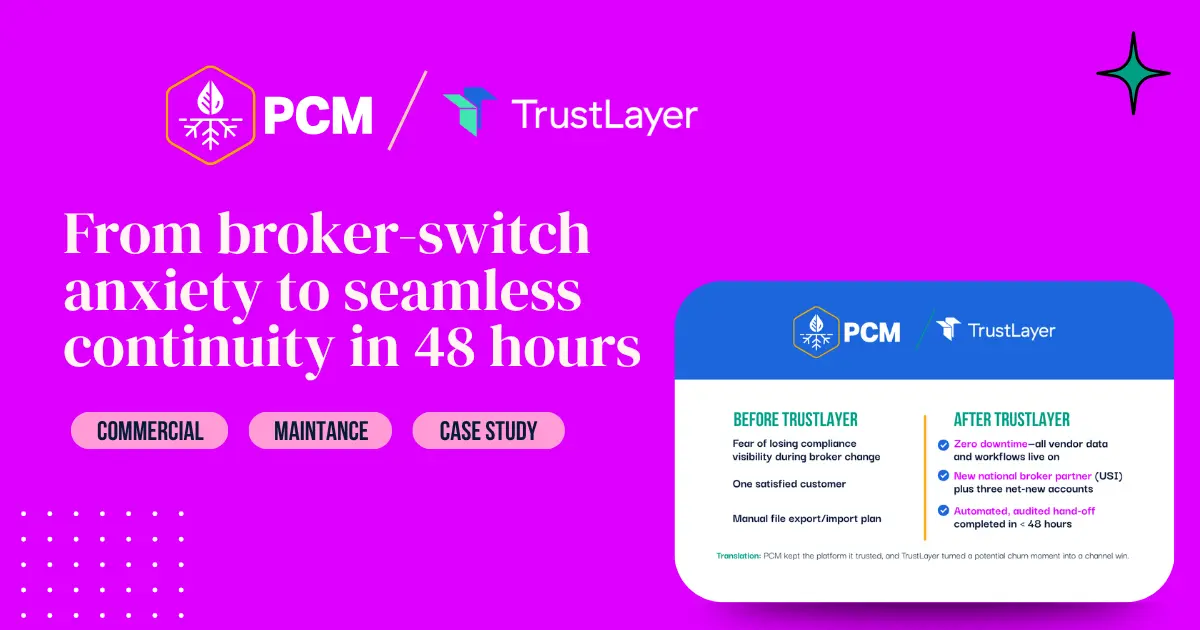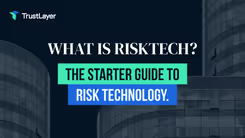Why Am I Being Asked for a COI

In today’s interconnected business world, the request for a COI—or Certificate of Insurance—is far more common than many realize. Whether you’re a freelancer, a contractor, a vendor, or even a small business owner, chances are you’ve been asked to provide a COI at some point. But why exactly is this document so important? What does it signify, and what should you know before handing it over?
This article dives deep into the reasons behind COI requests, exploring their role in risk management, business relationships, and compliance. Along the way, it will clarify common misconceptions and offer insights from licensed insurance professionals, including those at TrustLayer, to help you navigate this often confusing terrain.
Understanding What a Certificate of Insurance (COI) Really Is
At its core, a Certificate of Insurance is a document issued by an insurance company or broker that summarizes the key details of an insurance policy. It acts as proof that an individual or business has insurance coverage, outlining the types of coverage, policy limits, and effective dates.
Unlike a full insurance policy, a COI is a snapshot—a simplified summary that confirms coverage without revealing all the policy’s fine print. This makes it a quick and convenient way for businesses to verify that their partners or contractors carry the necessary insurance.
For example, if a construction company hires a subcontractor, the general contractor will likely request a COI to ensure the subcontractor has liability insurance. This protects the general contractor from financial exposure if the subcontractor causes property damage or injury on the job. In many industries, having a COI is not just a best practice but often a contractual requirement, ensuring that all parties involved are adequately protected against unforeseen risks.
Common Types of Insurance Shown on a COI
COIs typically include several types of insurance coverage, such as:
- General Liability Insurance: Covers bodily injury and property damage claims.
- Workers’ Compensation: Protects employees injured on the job.
- Professional Liability (Errors & Omissions): For service providers, covering mistakes or negligence.
- Commercial Auto Insurance: For vehicles used in business operations.
Knowing which types of insurance are relevant to your industry can help you anticipate COI requests and prepare accordingly. Additionally, it’s important to understand that COIs can also include endorsements or additional insured status, which can provide further protection by extending coverage to other parties, such as clients or project owners. This aspect is particularly vital in industries like construction, where multiple stakeholders are involved, and the risk of liability can be shared among them.
Furthermore, the process of obtaining a COI can vary depending on the insurer and the complexity of the coverage. Some businesses may find themselves needing to request multiple COIs for different projects or clients, each tailored to specific requirements. This can add an extra layer of administrative work but is crucial for maintaining compliance and safeguarding against potential legal issues. Understanding the nuances of COIs not only helps in managing risk but also fosters trust and transparency in business relationships.
Why Businesses Request a COI: The Role of Risk Management
Risk management is the primary driver behind COI requests. Simply put, businesses want to protect themselves from financial loss, legal liability, and reputational damage that could arise from working with uninsured or underinsured partners.
Imagine a scenario where a vendor causes property damage at a client’s site. Without proper insurance, the client could end up footing the bill for repairs or legal claims. By requiring a COI upfront, the client ensures the vendor has insurance to cover such incidents, shifting risk away from themselves.
Mitigating Financial Exposure
One of the biggest risks businesses face when engaging contractors or suppliers is unexpected costs from accidents or lawsuits. A COI provides reassurance that the other party has the financial backing to cover these costs, reducing the likelihood of costly disputes.
According to a 2023 survey by the Risk & Insurance Management Society (RIMS), over 70% of companies reported that verifying insurance coverage through COIs significantly reduced their risk exposure in vendor relationships.
Moreover, the financial implications of not having a COI can extend beyond immediate costs. Businesses may find themselves facing increased insurance premiums or difficulty securing coverage in the future if they have a history of working with uninsured partners. This ripple effect can hinder growth and operational flexibility, making it imperative for companies to prioritize COIs as part of their risk management strategy.
Compliance and Contractual Obligations
Many contracts explicitly require proof of insurance before work begins. This is not just a formality—it’s a contractual safeguard. Failing to provide a COI can delay projects, void agreements, or even result in lost business opportunities.
For industries like construction, healthcare, and event planning, regulatory bodies often mandate certain insurance coverages, making COIs essential for compliance. Businesses without the proper documentation risk fines, penalties, or license suspensions.
Additionally, the complexity of modern contracts often includes layers of subcontractors and suppliers, each with their own insurance requirements. This multifaceted landscape necessitates diligent tracking and management of COIs to ensure that all parties are compliant. Companies that implement robust systems for managing COIs not only protect themselves legally but also enhance their reputation as responsible and trustworthy partners in their respective industries.
Who Is Typically Asked to Provide a COI?
COI requests are common across a wide range of industries and roles. Understanding who is likely to be asked for a COI can help you prepare and avoid surprises.
Contractors and Subcontractors
In construction, renovation, and maintenance work, general contractors almost always require subcontractors to submit COIs. This ensures that every party on the job site carries appropriate insurance, protecting everyone involved.
For example, a roofing subcontractor will need to provide a COI showing general liability and workers’ compensation coverage before starting work on a commercial building. This requirement not only safeguards the contractor but also helps to maintain a safe working environment, as it ensures that all workers are covered in case of accidents. Additionally, having a COI can enhance a subcontractor's credibility, demonstrating their professionalism and commitment to risk management.
Freelancers and Consultants
Independent professionals offering services such as marketing, IT support, or design may also be asked for COIs, especially when working with larger corporations or government agencies. This is because even service providers can be held liable for errors, omissions, or damages. A graphic designer, for instance, might need to present a COI to a client to reassure them that they are protected against any potential copyright infringements or design flaws that could lead to financial loss.
Furthermore, having a COI can open doors for freelancers, as many companies prefer to work with insured professionals. It serves as a signal of reliability and professionalism, which can be a deciding factor in competitive bidding situations. Clients often feel more secure knowing that their consultants are covered, allowing for a more trusting and collaborative working relationship.
Vendors and Suppliers
Companies that supply goods or equipment might be asked for a COI to confirm they have product liability insurance or commercial general liability coverage. This protects the buyer if the product causes harm or damage. For instance, a supplier of industrial machinery will need to provide a COI to assure the purchasing company that they are financially protected in the event of equipment malfunction that leads to injury or property damage.
In addition to safeguarding the buyer, having a COI can also be a competitive advantage for vendors. It demonstrates a commitment to quality and accountability, which can influence purchasing decisions. Many businesses now require COIs as part of their vendor onboarding process, making it essential for suppliers to have their documentation in order to secure contracts and maintain good relationships with their clients.
What to Do When You’re Asked for a COI
Receiving a request for a COI can be confusing, especially if it’s your first time. Here are some practical steps to handle the situation smoothly.
Review Your Insurance Coverage
Before providing a COI, verify that your insurance policies are current and meet the coverage requirements specified by the requesting party. If you don’t have the necessary insurance, now is the time to speak with your insurance agent or broker.
TrustLayer’s licensed insurance professionals recommend regularly reviewing your policies to ensure they align with your business activities and contractual obligations. This proactive approach not only safeguards your business but also helps you avoid potential liabilities that could arise from insufficient coverage. Additionally, understanding the nuances of your policy can empower you to negotiate better terms with clients and partners.
Request a COI from Your Insurance Provider
Once you confirm your coverage, contact your insurance company or broker to request a COI. This document should clearly list the types of coverage, policy numbers, limits, and effective dates.
Many insurers can provide COIs electronically, speeding up the process and reducing paperwork. It’s also wise to check if your insurer offers a portal or mobile app for easy access to your insurance documents. This can streamline future requests and help you maintain an organized record of your insurance status, which is particularly useful during audits or contract negotiations.
Understand Additional Insured and Waiver of Subrogation Requests
Sometimes, the party requesting the COI will ask to be added as an “additional insured” on your policy. This extends certain protections to them and is a common practice in contracts.
Similarly, a waiver of subrogation prevents your insurer from pursuing the other party for damages after a claim. Both requests have implications for your coverage and should be discussed with your insurance professional. Understanding these terms can help you make informed decisions about your coverage and the risks you are willing to assume. It’s essential to weigh the benefits of these requests against any potential drawbacks, such as increased premiums or reduced coverage limits.
Keep Records and Follow Up
After submitting your COI, keep a copy for your records. If the requesting party has questions or needs updates—such as policy renewals—be prepared to provide revised certificates promptly.
Additionally, maintaining a detailed log of all COI requests and submissions can be beneficial for your business. This log can serve as a reference point for future engagements and help you track compliance with various contractual obligations. Furthermore, setting reminders for policy renewals or updates can ensure that you are always prepared to provide the necessary documentation without delays, thereby fostering trust and reliability with your clients and partners.
Common Misconceptions About COIs
Despite their prevalence, COIs are often misunderstood. Clearing up these misconceptions can help businesses and individuals approach COI requests with confidence.
A COI Is Not Insurance
Remember that a COI is proof of insurance, not the insurance itself. It does not guarantee coverage in every situation or protect you from all risks. Always maintain active and adequate insurance policies behind the COI.
Providing a COI Doesn’t Eliminate Risk
While a COI helps manage risk, it doesn’t eliminate it. There can still be gaps in coverage, disputes over claims, or situations not covered by your policy. That’s why it’s important to understand your insurance thoroughly.
COIs Can Be Customized
COIs can include endorsements, special conditions, and additional insured parties as required by contracts. They are not one-size-fits-all documents, so communication with your insurer and the requesting party is key.
Why TrustLayer’s Licensed Insurance Professionals Matter
Navigating COI requests can be complex, especially when dealing with multiple contracts, insurance types, and compliance rules. That’s where licensed insurance professionals come in.
TrustLayer’s experts bring deep industry knowledge to help businesses understand their insurance requirements and manage COI documentation effectively. Their guidance ensures that companies are not only compliant but also protected against unforeseen risks.
Whether you’re a small business owner or part of a large enterprise, consulting with licensed professionals can save time, reduce errors, and provide peace of mind when handling COI requests.
Looking Ahead: The Growing Importance of COIs in Business
As business relationships become more complex and risk environments evolve, the role of COIs is only set to increase. Digital transformation and regulatory changes are driving more stringent insurance verification processes.
According to recent industry reports, nearly 85% of companies now require COIs for third-party vendors, up from 65% just five years ago. This trend reflects a broader emphasis on proactive risk management and accountability.
Staying ahead means understanding why COIs are requested, what they represent, and how to manage them efficiently. It’s not just about compliance—it’s about building trust and safeguarding your business’s future.
Conclusion
Being asked for a Certificate of Insurance is a standard part of doing business today. It’s a vital tool for managing risk, ensuring compliance, and fostering trustworthy partnerships. By understanding what a COI is, why it’s requested, and how to respond, businesses and professionals can navigate these requests confidently and effectively.
If you want to learn more about insurance certificates, risk management, and best practices, be sure to check out other insightful articles from TrustLayer. For personalized advice, consider booking a consultation with our licensed insurance professionals who can help tailor solutions to your unique needs.
Ready to elevate your risk management strategy and streamline your COI processes? TrustLayer is here to revolutionize the way you handle insurance verification, with a platform designed for the modern risk manager. Say goodbye to the administrative burden of manual document collection and verification. Join the hundreds of thousands of companies that have already discovered the efficiency of TrustLayer's automated solutions. Embrace the future of risk management and let TrustLayer help you build next practices over best practices. Set up a time to talk with our team and see how we can tailor our leading solution to meet your unique needs.
















